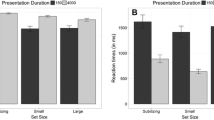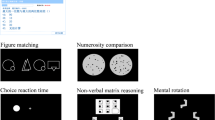Abstract
"Subitizing" defines a phenomenon whereby approximately four items can be quickly and accurately processed. Studies have shown the close association between subitizing and math performance, however, the mechanism for the association remains unclear. The present study was conducted to investigate whether form perception assessed on a serial figure matching task is a potential non-numerical mechanism between subitizing ability and math performance. Three-hundred and seventy-three Chinese primary school students completed four kinds of dot comparison tasks, serial figure matching task, math performance tasks (including three arithmetic computation tasks and math word problem task), and other cognitive tasks as their general cognitive abilities were observed as covariates. A series of hierarchical regression analyses showed that after controlling for age, gender, nonverbal matrix reasoning, and visual tracking, subitizing comparison (subitizing vs. subitizing, subitizing vs. estimation) still contributed to simple addition or simple subtraction but not to complex subtraction ability or math word problem. After taking form perception as an additional control variable, the predictive power of different dot comparison conditions disappeared. A path model also showed that form perception fully mediates the relation between numerosity comparison (within and beyond the subitizing range) and arithmetic performance. These findings support the claim that form perception is a non-numerical cognitive correlate of the relation between subitizing ability and math performance (especially arithmetic computation).


Similar content being viewed by others
Data availability
The datasets generated during and analyzed during the current study are available from the corresponding author upon reasonable request.
References
Agrillo C, Miletto Petrazzini ME, Bisazza A (2014) Numerical acuity of fish is improved in the presence of moving targets, but only in the subitizing range. Anim Cogn 17(2):307–316. https://doi.org/10.1007/s10071-013-0663-6
Anobile G, Stievano P, Burr DC (2013) Visual sustained attention and numerosity sensitivity correlate with math achievement in children. J Exp Child Psychol 116(2):380–391. https://doi.org/10.1016/j.jecp.2013.06.006
Anobile G, Cicchini GM, Burr DC (2016) Number as a primary perceptual attribute: a review. Perception 45(1–2):5–31. https://doi.org/10.1177/0301006615602599
Anobile G, Arrighi R, Burr DC (2019) Simultaneous and sequential subitizing are separate systems, and neither predicts math abilities. J Exp Child Psychol 178:86–103. https://doi.org/10.1016/j.jecp.2018.09.017
Bartelet D, Vaessen A, Blomert L, Ansari D (2014) What basic number processing measures in kindergarten explain unique variability in first-grade arithmetic proficiency? J Exp Child Psychol 117:12–28. https://doi.org/10.1016/j.jecp.2013.08.010
Burr DC, Turi M, Anobile G (2010) Subitizing but not estimation of numerosity requires attentional resources. J vis 10(6):20. https://doi.org/10.1167/10.6.20
Butterworth B (2010) Foundational numerical capacities and the origins of dyscalculia. Trends Cogn Sci 14(12):534–541. https://doi.org/10.1016/j.tics.2010.09.007
Butterworth B (1999) The mathematical brain (1 publ). Macmillan
Cheng DZ, Zhou AH, Yu X, Chen CS, Jia JP, Zhou XL (2013) Quantifier processing can be dissociated from numerical processing: Evidence from semantic dementia patients. Neuropsychologia 51(11):2172–2183. https://doi.org/10.1016/j.neuropsychologia.2013.07.003
Cheng D, Xiao Q, Chen Q, Cui JX, Zhou XL (2018) Dyslexia and dyscalculia are characterized by common visual perception deficits. Dev Neuropsychol 43(6):497–507. https://doi.org/10.1080/87565641.2018.1481068
Cheng D, Xiao Q, Cui J, Chen C, Zeng J, Chen Q, Zhou X (2020) Short-term numerosity training promotes symbolic arithmetic in children with developmental dyscalculia: the mediating role of visual form perception. Dev Sci. https://doi.org/10.1111/desc.12910
Cheng D, Cui Z, Chen C, Xu X, Niu K, He Z, Zhou X (2023) The database for extracting numerical and visual properties of numerosity processing in the Chinese population. Scientific Data 10(1):28. https://doi.org/10.1038/s41597-023-01933-6
Cui J, Georgiou GK, Zhang Y, Li Y, Shu H, Zhou X (2017) Examining the relationship between rapid automatized naming and arithmetic fluency in Chinese kindergarten children. J Exp Child Psychol 154:146–163. https://doi.org/10.1016/j.jecp.2016.10.008
Cui J, Zhang Y, Wan S, Chen C, Zeng J, Zhou X (2019) Visual form perception is fundamental for both reading comprehension and arithmetic computation. Cognition 189:141–154. https://doi.org/10.1016/j.cognition.2019.03.014
Desoete A, Ceulemans A, Roeyers H, Huylebroeck A (2009) Subitizing or counting as possible screening variables for learning disabilities in mathematics education or learning? Educ Res Rev 4(1):55–66. https://doi.org/10.1016/j.edurev.2008.11.003
Egeth HE, Leonard CJ, Palomares M (2008) The role of attention in subitizing: is the magical number 1? Vis Cogn 16(4):463–473. https://doi.org/10.1080/13506280801937939
Gray SA, Reeve RA (2014) Preschoolers’ dot enumeration abilities are markers of their arithmetic competence. PLoS ONE 9(4):e94428. https://doi.org/10.1371/journal.pone.0094428
Kaufman E, Lord M, Reese T, Volkmann J (1949) The discrimination of visual number. Am J Psychol 62(4):498–525. https://doi.org/10.2307/1418556
Landerl K (2013) Development of numerical processing in children with typical and dyscalculic arithmetic skills—A longitudinal study. Front Psychol. https://doi.org/10.3389/fpsyg.2013.00459
Major CS, Paul JM, Reeve RA (2017) TEMA and dot enumeration profiles predict mental addition problem solving speed longitudinally. Front Psychol. https://doi.org/10.3389/fpsyg.2017.02263
Melcher D, Piazza M (2011) The role of attentional priority and saliency in determining capacity limits in enumeration and visual working memory. PLoS ONE 6(12):e29296. https://doi.org/10.1371/journal.pone.0029296
Nieder A, Dehaene S (2009) Representation of number in the brain. Annu Rev Neurosci 32(1):185–208. https://doi.org/10.1146/annurev.neuro.051508.135550
O’Rear CD, McNeil NM (2019) Improved set-size labeling mediates the effect of a counting intervention on children’s understanding of cardinality. Dev Sci. https://doi.org/10.1111/desc.12819
Paliwal V, Baroody AJ (2018) How best to teach the cardinality principle? Early Child Res Quart 44:152–160. https://doi.org/10.1016/j.ecresq.2018.03.012
Paliwal V, Baroody AJ (2020) Cardinality principle understanding: the role of focusing on the subitizing ability. ZDM Mathematics Education 52(4):649–661. https://doi.org/10.1007/s11858-020-01150-0
Piazza M, Fumarola A, Chinello A, Melcher D (2011) Subitizing reflects visuo-spatial object individuation capacity. Cognition 121(1):147–153. https://doi.org/10.1016/j.cognition.2011.05.007
Poncet M, Chakravarthi R (2021) Subitizing object parts reveals a second stage of individuation. Psychon Bull Rev 28(2):476–486. https://doi.org/10.3758/s13423-020-01836-2
Raven J, Court J (1998) The interrelationships of mathematical precursors in kindergarten
Reeve R, Reynolds F, Humberstone J, Butterworth B (2012) Stability and change in markers of core numerical competencies. J Exp Psychol Gener 141(4):649–666. https://doi.org/10.1037/a0027520
Reigosa-Crespo V, Valdes-Sosa M, Butterworth B, Estevez N, Rodriguez M, Santos E, Torres P, Suarez R, Lage A (2012) Basic numerical capacities and prevalence of developmental dyscalculia: the Havana survey. Dev Psychol 48(1):123–135. https://doi.org/10.1037/a0025356
Reigosa-Crespo V, Gonzalez-Alemany E, Leon T, Torres R, Mosquera R, Valdes-Sosa M (2013) Numerical capacities as domain-specific predictors beyond early mathematics learning: a longitudinal study. PLOS ONE 8(11). https://doi.org/10.1371/journal.pone.0079711
Rodic M, Zhou X, Tikhomirova T, Wei W, Malykh S, Ismatulina V, Sabirova E, Davidova Y, Tosto MG, Lemelin J, Kovas Y (2015) Cross-cultural investigation into cognitive underpinnings of individual differences in early arithmetic. Dev Sci 18(1):165–174. https://doi.org/10.1111/desc.12204
Rodic M, Cui J, Malykh S, Zhou X, Gynku EI, Bogdanova EL, Zueva DY, Bogdanova OY, Kovas Y (2018) Cognition, emotion, and arithmetic in primary school: a cross-cultural investigation. Br J Dev Psychol 36(2):255–276. https://doi.org/10.1111/bjdp.12248
Soto-Calvo E, Simmons FR, Willis C, Adams A-M (2015) Identifying the cognitive predictors of early counting and calculation skills: evidence from a longitudinal study. J Exp Child Psychol 140:16–37. https://doi.org/10.1016/j.jecp.2015.06.011
Starkey P, Cooper R (1980) Perception of numbers by human infants. Science 210(4473):1033–1035. https://doi.org/10.1126/science.7434014
Trick LM, Pylyshyn ZW (1994) Why are small and large numbers enumerated differently—a limited-capacity preattentive stage in vision. Psychol Rev 101(1):80–102. https://doi.org/10.1037/0033-295X.101.1.80
Vetter P, Butterworth B, Bahrami B (2008) Modulating attentional load affects numerosity estimation: evidence against a pre-attentive subitizing mechanism. PLoS ONE 3(9):e3269. https://doi.org/10.1371/journal.pone.0003269
Zhang Y, Liu T, Chen C, Zhou X (2019) Visual form perception supports approximate number system acuity and arithmetic fluency. Learn Individ Differ 71:1–12. https://doi.org/10.1016/j.lindif.2019.02.008
Zhou X, Wei W, Zhang Y, Cui J, Chen C (2015) Visual perception can account for the close relation between numerosity processing and computational fluency. Front Psychol. https://doi.org/10.3389/fpsyg.2015.01364
Zhou X, Hu Y, Yuan L, Gu T, Li D (2020) Visual form perception predicts 3-year longitudinal development of mathematical achievement. Cogn Process 21(4):521–532. https://doi.org/10.1007/s10339-020-00980-w
Acknowledgements
This research was supported by three grants from the Natural Science Foundation of China (31671151), the 111 Project (BP0719032), and a grant from the Advanced Innovation Center for Future Education (27900-110631111).
Author information
Authors and Affiliations
Corresponding authors
Ethics declarations
Conflict of interest
The authors declare that they have no conflict of interest.
Ethical approval
All procedures performed in studies involving human participants were in accordance with the ethical standards of the institutional and national research committee and with the 1964 Helsinki Declaration and its later amendments or comparable ethical standards.
The study was approved by the institutional review board at the State Key Laboratory of Cognitive Neuroscience and Learning, Beijing Normal University.
Informed consent
Informed consent was obtained from all individual participants included in the study.
Additional information
Publisher's Note
Springer Nature remains neutral with regard to jurisdictional claims in published maps and institutional affiliations.
Editors: Daniele Nardi (Ball State University), Stefano Federici (University of Perugia); Reviewers: Paolo Stievano (Sapienza University of Rome) and a second researcher who prefers to remain anonymous.
Rights and permissions
Springer Nature or its licensor (e.g. a society or other partner) holds exclusive rights to this article under a publishing agreement with the author(s) or other rightsholder(s); author self-archiving of the accepted manuscript version of this article is solely governed by the terms of such publishing agreement and applicable law.
About this article
Cite this article
Cui, Z., Hu, Y., Wang, X. et al. Form perception is a cognitive correlate of the relation between subitizing ability and math performance. Cogn Process 25, 321–331 (2024). https://doi.org/10.1007/s10339-024-01175-3
Received:
Accepted:
Published:
Issue Date:
DOI: https://doi.org/10.1007/s10339-024-01175-3




